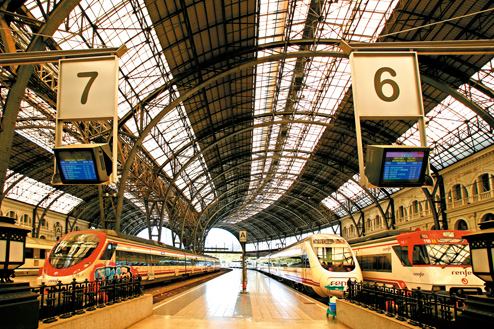Food & Drink
Barcelona has a fine Mediterranean cuisine, with markets full of enticing cured meats (embotits/embutidos) and wonderful fresh seafood. Dining out is more expensive here than in other regions of Spain. A typical bar in Granada, Seville or Madrid will most likely offer free tapas with your beer, whereas here there is no such generosity. A medium-sized tapa will usually cost around 4-5 euros. If on a tight budget, a menu del dia generally provides the best value, costing as little as seven euros. This includes a starter, main course and a dessert, as well as wine, water and bread. A typical menu will often feature Spanish staples such as gazpacho (cold soup with tomato, garlic and peppers), tortilla (omelette) and albóndigas/mandonguilles (meatballs), as well as local specialties. A tasty starter is escalivada, aubergine, red peppers and onions marinated in olive oil and spices whilst paella, a rice dish spiced with saffron and turmeric, is always a good introduction to Spanish cuisine. Fideua tastes like paella but is made with noodles instead of rice, and comes with a serving of all-i-olli (oil and garlic sauce) on the side. An exceedingly popular springtime dish is calçots, onions shaped like leeks, dipped in romesco sauce. Fricandó is a veal dish cooked with plums and rovellòn mushrooms. Barcelona’s location by the sea means there is a wealth of seafood cuisine, including calamars a la romana (fried squid rings), sèpia (octopus) and exqueixada de bacallá (marinated raw cod with peppers, tomatoes and olives). Bread is particularly important at the dining table. Instead of buttering their bread, Catalans like to crush tomato into the dough and dribble olive oil and salt over it. This is known as pan amb tomaquet and is a local institution. Fillings for a traditional bocata (baguette) include botifarra blanc (white pork sausage), choriço (chorizo sausage), or the traditional Spanish jamon serrano (cured serrano ham).
Christmas treats include roast suckling, lobster and bacallá (cod) as well as dozens of sweet fancies such as turron, marzipan and polvoron (powder cake). In Catalonia there are ten wine producing regions. Penedés, Costers del Segre, Pla El Bages and Alella are known for their white wines, Conca de Barbara, Empordà and Costa Brava for their rosés, while Tarragona produces sweet wines. More general produce is associated with the regions of Piorat and Terra Alta. Sitting on one of the terraces of El Born to savour a glass of Catalonia’s locally produced wine is a must. During festivals and at family get-togethers, wine is traditionally enjoyed from a peaked jar called a porròn.
Christmas treats include roast suckling, lobster and bacallá (cod) as well as dozens of sweet fancies such as turron, marzipan and polvoron (powder cake). In Catalonia there are ten wine producing regions. Penedés, Costers del Segre, Pla El Bages and Alella are known for their white wines, Conca de Barbara, Empordà and Costa Brava for their rosés, while Tarragona produces sweet wines. More general produce is associated with the regions of Piorat and Terra Alta. Sitting on one of the terraces of El Born to savour a glass of Catalonia’s locally produced wine is a must. During festivals and at family get-togethers, wine is traditionally enjoyed from a peaked jar called a porròn.













